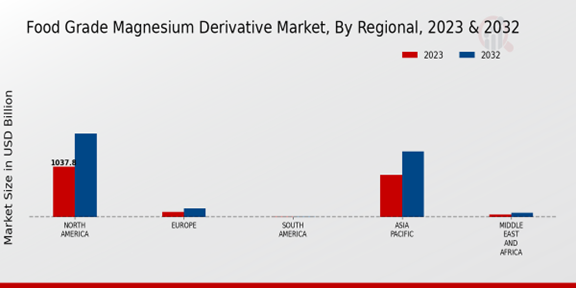Market Growth Projections
The Global Food Grade Magnesium Derivative Market Industry is poised for substantial growth, with projections indicating a market value of 2351.9 USD Billion by 2035. This growth trajectory is underpinned by a compound annual growth rate (CAGR) of 5.52% from 2025 to 2035. The increasing application of magnesium derivatives across various sectors, including food and beverages, supplements, and pharmaceuticals, suggests a robust demand landscape. As manufacturers innovate and expand their product lines, the market is likely to attract significant investments, further fueling its expansion. This positive outlook reflects the industry's adaptability to changing consumer preferences and regulatory landscapes.
Regulatory Support for Food Safety
Regulatory frameworks play a pivotal role in shaping the Global Food Grade Magnesium Derivative Market Industry. Governments worldwide are implementing stringent regulations to ensure food safety and quality, which in turn drives the demand for food-grade additives, including magnesium derivatives. Compliance with these regulations necessitates the use of high-quality ingredients, thereby boosting the market for food-grade magnesium derivatives. As regulatory bodies continue to emphasize the importance of food safety, manufacturers are likely to invest in sourcing premium magnesium derivatives to meet these standards, further propelling market growth.
Technological Advancements in Production
Technological advancements in the production of food-grade magnesium derivatives are transforming the Global Food Grade Magnesium Derivative Market Industry. Innovations in extraction and processing techniques enhance the efficiency and quality of magnesium derivatives, making them more accessible to manufacturers. These advancements not only improve product consistency but also reduce production costs, thereby encouraging wider adoption across various food applications. As the market evolves, companies that leverage these technologies are likely to gain a competitive edge, contributing to the overall growth of the industry. The anticipated CAGR of 5.52% from 2025 to 2035 underscores the potential for continued expansion driven by technological progress.
Expansion of the Food and Beverage Sector
The Global Food Grade Magnesium Derivative Market Industry is significantly influenced by the expansion of the food and beverage sector. As the industry evolves, there is a growing need for food additives that enhance nutritional value and improve product stability. Magnesium derivatives are increasingly utilized in various food applications, including fortification and preservation. This trend is expected to contribute to the market's growth, with projections indicating a market value of 2351.9 USD Billion by 2035. The integration of magnesium derivatives into food products aligns with consumer preferences for healthier options, thereby driving demand and fostering innovation within the sector.
Rising Demand for Nutritional Supplements
The Global Food Grade Magnesium Derivative Market Industry experiences a notable surge in demand for nutritional supplements, driven by increasing consumer awareness regarding health and wellness. Magnesium plays a crucial role in various bodily functions, and its derivatives are increasingly incorporated into dietary supplements. In 2024, the market is projected to reach 1302.1 USD Billion, reflecting a growing trend towards preventive healthcare. This shift is further supported by the rising prevalence of magnesium deficiency among populations, prompting manufacturers to innovate and expand their product offerings. As consumers prioritize health, the demand for food-grade magnesium derivatives is likely to continue its upward trajectory.
Consumer Trends Towards Natural Ingredients
The Global Food Grade Magnesium Derivative Market Industry is witnessing a shift in consumer preferences towards natural and organic ingredients. As consumers become more health-conscious, there is a growing demand for food products that contain natural additives, including magnesium derivatives. This trend is evident in the increasing popularity of organic food products that incorporate food-grade magnesium for its health benefits. Manufacturers are responding to this demand by reformulating products to include natural magnesium sources, thereby enhancing their market appeal. This shift towards natural ingredients is likely to sustain the growth of the market, as consumers continue to prioritize health and wellness in their purchasing decisions.


















